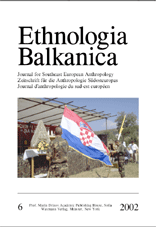The Ethnicity of Aromanians after 1990: the Identity of a Minority that Behaves like a Majority
The Ethnicity of Aromanians after 1990: the Identity of a Minority that Behaves like a Majority
Author(s): Thede KahlSubject(s): Anthropology
Published by: LIT Verlag
Keywords: Ethnicity of Aromanians; Aromanian diaspora; Aromanians and Romania; Aromanians and Greece;
Summary/Abstract: Even if some publications have occasionally voiced opinion that may have been considered politically dangerous by some governments, today none of the Aromanian newspapers or organisations supports independence for Aromanians. The activities of most Aromanians living in Western Europe focus on the maintenance of the Aromanian language, culture and identity. In their countries of origin, however, their success has been rather limited. The most active members in Aromanian Internet discussion groups are diaspora Aromanians. Some Aromanian groups in southeast Europe and in the diaspora have begun to intensify Aromanian activities. Whether these groups of activists will succeed in consolidating a permanent national identity based on a “dzua natsiunalā” (national day), a “limba ahoryea” (coherent language) and minority status in several countries of Europe, or if they will be totally assimilated into other cultures, is to be seen. Aromanians will continue to have difficulties in finding a way between Greek, Romanian and other orientations. Most pro-Romanian Aromanian activists with their anti-Greek position exclude the most numerous and developed segment of Aromanians, while most of pro-Greek activists with their xenophobic attitude towards Romanian propaganda exclude all activities aimed at improving the status of the Aromanian language. Thus, even in the case of guaranteed minority rights, the promotion of language instruction and of cultural meetings, no lasting survival of Aromanian can be guaranteed. To reach this aim it would be necessary to improve the image of Aromanian, to decide on a uniform orthography accepted by Aromanians in all countries and, above all, to increase the ability for compromise and cooperation among all Aromanians in the Balkans. It is unclear, though, if the majority of the southeast European Aromanians would consider these as their goals.
Journal: Ethnologia Balkanica
- Issue Year: 2002
- Issue No: 06
- Page Range: 145-169
- Page Count: 25
- Language: English
- Content File-PDF

